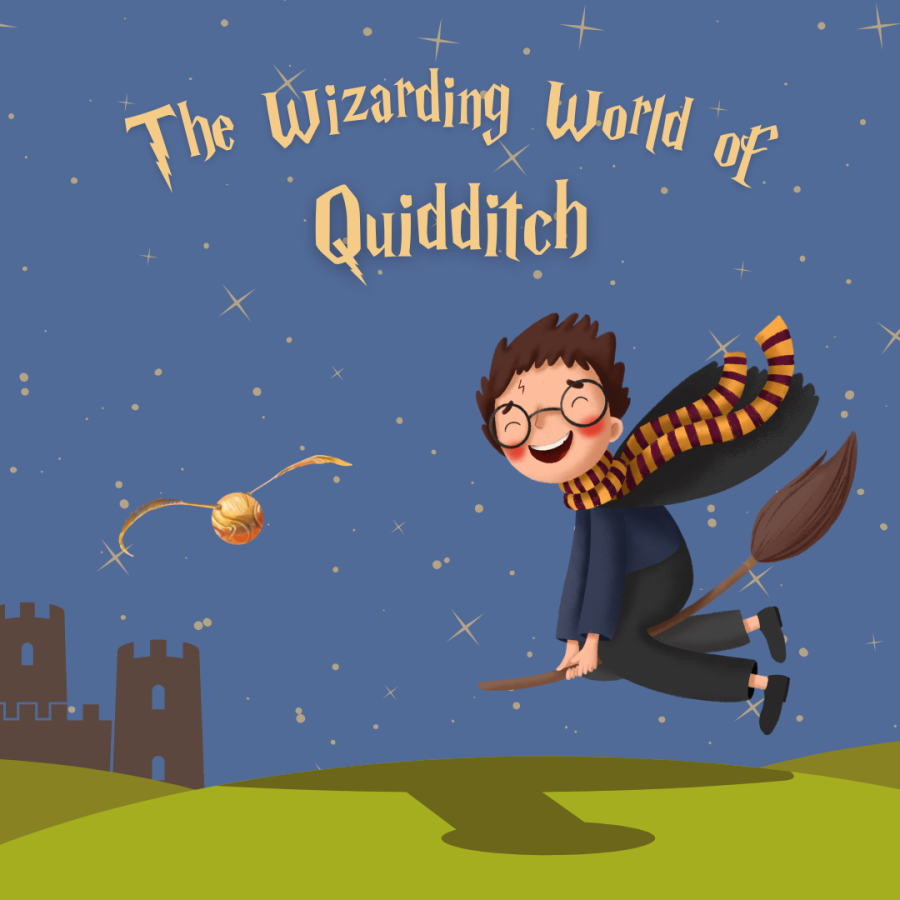The Magical, Wizarding World of Quidditch
February 26, 2022
Flying golden snitches, quaffles and broomsticks; the fictional game of Quidditch —
originating from the Harry Potter books and movies — combines magic, excitement and flying broomsticks.
Although Quidditch is a fictional game within the Harry Potter universe, there is a long history behind it, mentioned in J.K. Rowling’s — author of the Harry Potter franchise — 2001 installment, aptly titled “Quidditch Through the Ages.”
Quidditch has been historically adapted from various elements of the ancient game within the Wizarding World. However, the first game of Quidditch started around 1050 and has continued on to becoming the most popular game of the Wizarding World. If one were to compare the game itself and its success to a real-life sport, it would be similar to that of British football, known in the U.S. as soccer. With the addition of flying broomsticks, of course.
So what is the main objective of Quidditch? The goal of Quidditch is similar to the majority of sports and games: score more points than your opponents; whichever team gains the most points by the end of the game is declared the winner. Each team consists of three chasers, a seeker, two beaters and a keeper. There are also four balls that the game uses: a quaffle, two bludgers and a golden snitch.
To start the game, the referee throws the quaffle into the air, signaling that the game has begun. It is up to the chasers to fly around on their broomsticks and catch and throw the quaffle through any of the three-goal hoops placed on their side — which Harry Potter compares the resemblance of enlarged muggle “bubble-blowing wands.” The keeper, on the other hand, is in charge of blocking the quaffles that are thrown by the opposing team. If a chaser successfully throws a quaffle into one of the goal hoops, that team wins 10 points.
As for the bludgers, they are made to make the game more difficult. A black iron ball similar to the shape of a basketball, beaters throw the bludgers to the opposing team to try to knock players off their broomsticks. Therefore, it is up to the players to remain aware of their surroundings at all times and quickly move away from the bludgers on their broomsticks. This is why a Quidditch player must be gifted with the skill of their brooms and have a great sense of agility as well as awareness in order to play the game well.
Now onto the position of seeker, Harry Potter’s famed position in the game. Sometime into the second half of the game, a small golden ball called the “golden snitch” is released onto the field. It is the duty of the seeker to point out the golden snitch and capture it before the opposing team’s seeker captures it. The role of seeker is meticulous being that a seeker must have a good eye, be fast, quick and gifted with one’s broom to capture the swift-moving snitch and — similarly to a chaser — have a good sense of one’s surroundings so that the seeker does not knock into any surrounding players or bludgers. The role of seeker is an important one because once the seeker catches the golden snitch, their team receives an automatic 150 points and ends the game with a win. To put it simply, the seeker acts as the final say for the game.
Over the course of the past two decades, as the Hary Potter franchise has grown into one of the most famous names in entertainment and book history, the once fictional game of Quidditch has been adapted to a real-life sport played in some colleges and universities, with a few added exceptions of course.
The real-life game of Quidditch originated in 2005 when some students from Middlebury College in Vermont wanted to make the sport their own.
In the real-life version of Quidditch, teammates wear the color of their respective position. Seven players play at a time on the field, alternating as the game continues. Each player must play the game holding a broom or stick, where they run around the field — which is approximately the size of a football or soccer field — trying to throw balls in one of three-goal hoops. Similar to fictional Quidditch, every successful throw is worth 10 points.
Because flying quaffles, bludgers and golden snitches do not exist in the Muggle world, each ball is replaced with its own ball from various other sports. A quaffle is replaced with a volleyball, a bludger is replaced with a dodgeball and the golden snitch is replaced with a tennis ball. The role of the golden snitch is vastly different from fictional quidditch, however.
In muggle Quidditch, the golden snitch is also a position. In the position of golden snitch, a team member of neither team’s side is dressed in gold and wears a golden velcro strap with the tennis ball attached. The team member of the golden snitch is the fastest player on the team, and when the game reaches 20 minutes, must run around the field evading capture from players. It is the job of the seeker to capture the velcro strap of the golden snitch. Capturing the velcro strap is a total of 30 points. However, different from fictional Quidditch, the game does not stop when a player captures the golden snitch the first time. Either seeker from either team must capture the golden snitch enough times to reach at least 70 points. Once 70 points are obtained by either team’s seekers, the game is over and points are counted up to determine the final winner.
With more colleges adapting the game, such as Flagler College and University of Florida amongst various other colleges, Quidditch is taking the world by storm as it begins to be viewed as a professional sport with a huge following as the Harry Potter franchise continues to influence everyday life.









